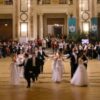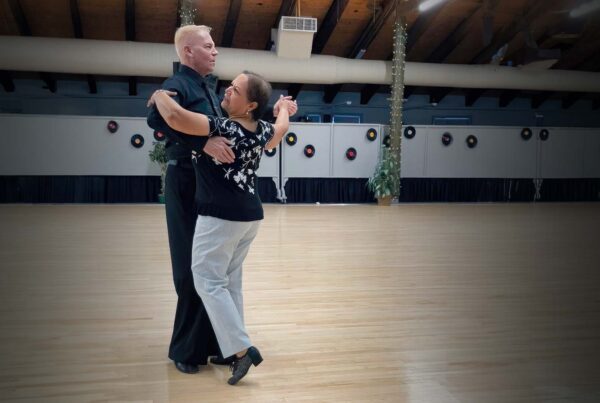At a recent competitionI once again observed an issue that is all too common at DanceSport comps. While the music was overall quite good throughout the event, a number of songs had poor phrasing or lacked the character of the dance they were for.
Let me make this clear: I’m not criticizing the event DJ in any way. He did a great job. My comments only reflect the need for all DanceSport DJs to understand the incredible responsibility they have when they take on that role. As someone who has attended many competitions (18 last year alone), I’ve noticed that many DJs see it as a fun job (which it is) and not as an awesome responsibility to help build the sport — for the athletes, audience and organizers. At an after-event dinner, these issues were discussed and I realized I’m not the only dancer who feels this way.
Recently at another competition, all the music for the entire event was slowly faded in at the start of each song. This was tragic! Every competitor hated the experience. You couldn’t tell where the phrasing was because you couldn’t hear that vital first beat of music. Some songs have a short intro bar or two. Or four. Others start their phrasing right away. With that “fade in” approach, it was impossible to know what you were dealing with. Even the Paso Doble faded in, but that wasn’t the worst of it. The first four bars of Paso sound exactly the same, and only when we reached the fifth bar did I realize that the DJ actually missed the entire first bar of music, fading in the song halfway through the second bar! This put the entire dance into a position that was unfair to the athletes and the audience.
At this point, the dancers have no choice but to start thinking about things other than their performance. Now they have to fix a problem that really has no place in the event: a problem caused purely by a DJ’s lack of awareness of musical issues.
An experience like that robbed the dancers of the ability to perform at the highest level they have trained to perform at. It robbed the audience of seeing the highest quality performances which they paid for. And it robbed the organizers of potential future revenue because many participants are so unhappy with the experience they don’t intend to return next year. To be fair to the DJ, as I talked with him after the event, the computer system was automatically doing the fading in. But in my opinion he should have considered this unacceptable and changed the settings so that it wouldn’t happen.
As competitors, we don’t know what music we’ll get at a competition. All we know is that it will match certain “bars per minute” guidelines governed by the authorities who look after the sport, and that it will be someone’s interpretation of the kind of music for that particular dance. I’ve met DJs who don’t understand any of the musical qualities involved. They don’t know the difference between American Style and International Style. They don’t know the history of the dances or their characters. One even said to me that he tries to find unusual stuff that nobody has ever heard before because he gets tired of the “typical” dance music played at events. This interpretive aspect is what I’d like to discuss, because it can make or break the performances on the floor.
There are three primary concerns that many DanceSport athletes share when it comes to competition music:
1. Consistent Phrasing
Music is phrased. Many dance songs, like Jive or Quickstep are phrased in groups of four bars of eight beats, a total of 32 beats per phrase. Samba is phrased. Even 3/4 music like Viennese Waltz is phrased, though in bars of eight. Waltz, Tango and Cha Cha are least impacted by phrasing, but it applies strongly to all the other dances. The routines are almost always choreographed to match those phrasings. When a routine is “out of phrase” it makes the routine look weak and disorganized. The beginning of a new phrase has additional power and drama in the music and this should be reflected by the routine through a change of direction or other emphasis to match the energy of the music.
What many dance DJs don’t realize is that a number of songs don’t follow the normal phrasing patterns all the way through. Last night, a Quickstep was played for a syllabus event that had several 4-bar phrases and suddenly a 2-bar phrase, then more 4-bar phrases and then another 2-bar phrase. Now, I realize that these syllabus dancers were probably unaware of the phrasing problems, but their routines were no doubt created in phrases and this has the end result of making all their routines look out of place halfway through the event. This is unfair to everyone!
Madonna’s “Hanky Panky” has been a popular Jive song played at many competitions. How many dance DJs are remotely aware that it has a messy mixture of 3-bar and 4-bar phrases, and even some 2-bar phrases? It’s a fun song, but completely wrong for a dance competition where dancers are depending on phrasing to make their dances look as good as possible.
Dean Martin’s “That’s Amore” has been played at competitions as a Viennese Waltz. Instead of consistent 8-bar phrases it varies, with several places where the phrasing is interrupted. While in fairness most dancers at this level can adapt, especially in this dance, why force them to do it when there are hundreds of songs with consistent phrasing? If you want Dean Martin, play “Bella Bimba” instead, which has proper phrasing all the way through.
The audience is paying money to see the best possible dancing. They are being robbed when routines are out of phrase for no reason other than a DJ didn’t do his or her homework!
2. Character of the dance
Another major issue at competitions is music that has none of the character of the dances. Just because a song has the right number of bars per minute does not make it appropriate!
How often have I been to competitions where I’ve heard Tango or Cha Cha songs that have none of the staccato qualities of those dances. I’ve heard flat Jive songs with no bounce or bee-bop swing qualities. I’ve heard Waltz songs with far too many beats and rhythms in them. I’ve heard square Slow Foxtrot music that didn’t sound like a romantic walk in the park but more like something you’d hear at the neighborhood pub after everyone has had too much to drink. This is wrong! You have a responsibility as a DJ to play music that matches the character qualities of the dance it is for.
Just because a song appears on a dance CD and has a genre listed next to it doesn’t make it right for competition. Many of those tracks are intended for practice or show dance use.
A Quickstep song I’ve heard far too often at competitions is called “Man With the Hex.” While some dancers actually like it as a song, I don’t feel this heavy metal, rough sounding piece has any place as a Quickstep song in competitive events. Let people make a show dance out of it, so they can emphasize the roughness in their own way. The Quickstep originated from party dances like the Charleston. It needs to have music that’s fun and light and frisky, not flat and shrieking heavy metal. I’ve heard audience members, especially older ones who dance socially, complain loudly about that song.
3. Suitability for the skill level
It’s really unfortunate when dance DJs at a competition play songs for low skill levels like Bronze or Silver that have a very complex musical pattern or have beats that are too hard to read because of the style.
I’ve seen this far too often, and it puts the dancers at such a disadvantage! At those levels, they are still struggling with foot placement and partnership issues. They are learning to dance, and not ready for difficult music. So, when a song comes on with several layers of beat counts within the music, it can be tragic.
Nat King Cole’s “Illusion” is a beautiful Waltz piece, but it’s much too hard for a new dancer to read. The vocals are so dominant and the emphasis placed in positions that don’t match the orchestral underlay. Don’t play it for Bronze, but leave songs like that for the higher level dancers who know how to read the music.
If you’re a dance DJ, I would recommend the following exercises:
- Go online and study the history of each dance. There are a number of web sites with this information.
- Listen to every single song you’re going to play, all the way through. Count the beats and bars. Write them down, ticking off the bars to see how many happen in each phrase. If it isn’t consistent, take it off your playlist. Sure, you’ll lose some songs you might like, but your responsibility to the sport is greater than your personal preferences.
- Ask yourself if the song is suitable for the skill level it’s slotted for. Songs with complex layered patterns, or hidden beats or other sophistication should be reserved for the higher levels.
Remember that you are a part of an amazing sport. Your role is just as important as that of everyone else in the competition. We are all in this together. The audience has paid money for a performance, and deserves to see the best performance possible from the dancers on the floor. The music you play will either help deliver that, or could take away from it.













